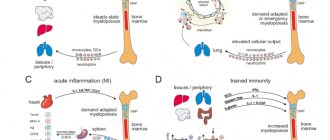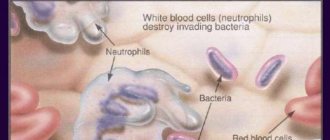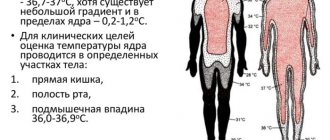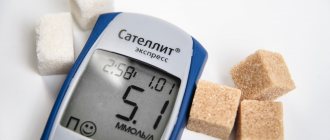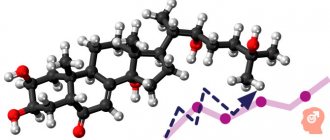What it is
Basophils are a type of leukocyte (white blood cell).
Produced in the bone marrow and present in small quantities in the body. The proportion of basophils from the total number of leukocytes in an adult healthy person is only 0.5-1%. This relatively small presence in the blood is enough for basophils to perform their functions. These include:
- Maintenance of allergic reactions. They migrate to allergic foci, where they release the contents of their granules (histamine, heparin), which ensures the maintenance of the allergic reaction1.
- Protection from foreign agents. Basophils are part of the innate immune system. They are activated upon contact with foreign agents. In particular, this is indicated for parasites.
- Sources of cytokines. Basophils secrete interleukins 3 and 4. In turn, the latter enhance the activity of other immune cells during infectious and inflammatory reactions.
- Improved blood flow. Basophils contain heparin, a blood thinner. During inflammatory processes, this allows immune cells to freely enter the site of inflammation.
Figure 1. Spatial model of the basophil. Image: Blausen.com staff (2014). "Medical gallery of Blausen Medical 2014". WikiJournal of Medicine 1 (2). DOI:10.15347/wjm/2014.010. ISSN 2002-4436 (CC BY 3.0)
Basophils in the classification of leukocytes
Leukocytes are granular and non-granular. Non-granular cells include cells with a solid nucleus and no inclusions in the cytoplasm, while the other group, in addition to inclusions, has segmentation of the nucleus. The classification is clearly shown below.
1. Granular leukocytes (granulocytes):
- Neutrophils are the main type of leukocytes. Their task is to capture bacteria during the process of phagocytosis and destroy them using enzymes and other protein substances of the granules.
- Eosinophils are involved in the production of antibodies and the development of an allergic reaction. They can only absorb small pathogens.
- Basophils form an allergic response.
2. Non-granular leukocytes (agranulocytes):
- Lymphocytes produce antibodies, destroy pathogens and regulate the activity of other cells. B-lymphocytes create antibodies to foreign structures, different groups of T-lymphocytes regulate immunity and antibody synthesis in different ways, and NK-lymphocytes destroy cells that differ from normal ones in one way or another.
- Monocytes are large cells that can capture large pathogens without dying.
Granular leukocytes are named according to their ability to absorb a particular dye when examined under a microscope. Basophils, for example, stain only with a basic dye, while eosinophil structures can only change color with acidic eosin. There are fewer basophils in the blood than other leukocytes.
Blood test for basophils
Basophils are determined as part of a clinical blood test. In medical documents, the indicator is referred to as “basophils”, “BA%”, “BA” or “BASO”.
Typically, basophils are expressed as a percentage of the total number of remaining white blood cells (BA%). Their absolute number can also be indicated (BA - the number of cells per liter of blood). This is 0.01-0.065x109/l., which is approximately 0.5-1% of the total number of white blood cells.
Cell counting is performed in a special device - a hematology analyzer. This is also done manually. A blood smear is taken, stained with special dyes, after which the basophils are counted under a microscope.
Basophil activation testing is carried out as part of an allergy test. It is possible to find out which allergens the basophils are activated to in order to identify the specific allergen that causes adverse symptoms.
Preparing for analysis
A general blood test requires proper preparation. Before the study, it is important to adhere to the following rules:
- Blood must be donated on an empty stomach. Otherwise, nutrients (entered into the blood) may interfere with the correct determination of the blood formula.
- You should refrain from smoking for several hours before donating blood.
- It is advisable to abstain from alcohol 2-3 days before the planned analysis.
- The day before donating blood, avoid physical and emotional stress.
- The day before you should refrain from taking medications (if possible). If you cannot refuse the medication, you should notify your doctor.
Basophils and estrogens
It has been established that drugs containing estrogen increase the number of basophils. Therefore, if you are taking such drugs, tell your doctor. When deciphering the analysis for basophil content, the specialist will make an adjustment for this.
Norms of basophils in the blood
The normal level of basophils in the blood (BASO) changes in children under 2 years of age.
In adults (men and women), the norm is 0.5-1% (Table 1). Table 1. Norm of basophils (BASO) in the blood by age and gender
| Newborns | Up to 1 month | One year old children | Children under 2 years old | Adults (men, women) | |
| Basophil level (BASO) | 0,75% | 0,5% | 0,6% | 0,7% | 0,5-1% |
Causes of elevated basophils
A high level of basophils is called basophilia. This condition can be dictated by both pathological and physiological reasons. Let's take a closer look at them.
Physiological causes of increased basophils:
- Menstruation and ovulation, when there is a high level of female sex hormones in the blood. As mentioned above, estrogens increase the level of basophils.
- The recovery period after an infection (basophil levels may be elevated for several days or weeks).
- When exposed to small doses of radiation. Often, an increased number of basophils is observed among radiologists or laboratory technicians.
- After taking contraceptives containing estrogen.
Pathological causes of high basophil content:
- allergic reactions²;
- bone marrow diseases³;
- thyroid deficiency (hypothyroidism);
- inflammatory diseases;
- ulcerative colitis;
- autoimmune diseases (eg rheumatoid arthritis4);
- asthma;
- infectious pathologies (viral, bacterial, fungal, parasitic).
Basophilia in children can be caused by other reasons, including:
- poisoning;
- parasites (worms);
- insect bites;
- anemia (iron deficiency, hemolytic);
- allergy;
- nephrotic syndrome;
- sinusitis;
- blood diseases;
- endocrine diseases (usually thyroid diseases);
- gastrointestinal pathologies.
Basophils are counted both manually and under a microscope. Photo: gstockstudio / freepik.com
Causes of low basophils
A decreased level of basophils is called basopenia. This condition is not dangerous to health. It can occur, for example, when basophils migrate from the blood to inflammatory foci. If the basophil has released its granules, then it is already considered inactive. Such cells are not taken into account when counting. For doctors, “empty” basophils serve as an additional diagnostic criterion, which indicates the presence of an inflammatory reaction.
Common causes of a pathological decrease in basophils include:
- Hyperthyroidism is an overactive thyroid gland.
- Urticaria is an allergic disease that manifests itself as a skin rash.
- Lupus is an autoimmune pathology in which foci of inflammation form in the joints, skin, heart and brain.
- Taking corticosteroid drugs. If you are taking such medications, please notify your doctor so that the results can be corrected.
- Depression. The mechanism of the decrease in basophils in depression is unknown, but the fact itself has been established.
- Smoking – contributes to a slight decrease in the level of basophils5. After giving up the bad habit, basophils rise again to normal levels.
Smoking reduces basophil levels. Photo: freepik.com
Possible violations
Knowledge of the role of basophils suggests that most of them are found in the blood when the body needs a protective reaction. This may be due to foreign substances, poisons, invasion of the body by bacteria, severe inflammation or even tumors. To make an accurate diagnosis, doctors not only look at the number of basophils, but also evaluate the content of other cells in the blood.
| Cause | Change in the number of basophils | Other changes in the blood | Possible additional tests |
| Allergy | 1-2% (change less than half) | Moderate increase in the number of leukocytes, a sharp increase in eosinophils, high levels of immunoglobulin E | Immunogram, collection of information about intolerance, skin test, allergy chip |
| Autoimmune diseases | Individually, growth indicates the acute phase of the disease | Increased ESR, possible leukocytosis | Blood for rheumatoid tests (rheumatoid factor, antibodies to streptococcus, C-reactive protein, plasma protein level), urine test |
| Nonspecific ulcerative colitis | Individually | Decrease in the number of red blood cells and hemoglobin, possible leukocytosis, increase in ESR, platelet count | Immunological blood test, biochemical analysis, feces for occult blood, coprogram |
| Myxidema | Low hemoglobin, many lymphocytes and eosinophils, low levels of thyroid-stimulating hormones | Blood for hormones T4, T3 TSH, ultrasound and scintigraphy of the thyroid gland | |
| Chronic hemolytic anemia | Low red blood cells, hemoglobin | Blood tests for bilirubin, stool and urine tests, bone marrow biopsy | |
| Acute infectious liver diseases | Increase in bilirubin, triglycerides, possible decrease or increase in leukocytes, decrease in hemoglobin, thrombocytopenia, increase in ESR | Analysis for immunoglobulins, bilirubin, liver enzymes, triglycerides | |
| Helminthiasis | Individually, growth only in the acute period | Eosinophilia, antigens to parasitic worms | Linked immunosorbent assay |
| Chronic myeloid leukemia | Up to 5-20% | Many granulocytes with a predominance of young forms, anemia is possible | Bone marrow puncture, PCR analysis, fluorescent hybridization, cytogenetic study |
| Mast cell leukemia | Neutrophil growth | Skin biopsy, histamine in urine, abdominal ultrasound, x-ray | |
| Polycythemia vera | Erythrocytosis, leukocytosis, thrombocytosis | Trephine biopsy, liver function tests, general urinalysis |
It is important to understand that minor fluctuations in basophils are quite normal, as is a single test result that, according to indications, falls outside the norm. The greatest accuracy is achieved by repeating the procedure three times every 2-3 days. It is best to donate blood in the same laboratory, so as not to increase the error from different instruments.
Basophilia in allergies
An allergic response is caused by a person encountering a substance that has already been recognized by his body as dangerous. The cause could be anything: from pollen and dust to a component of some rare material. Some reactions develop instantly, others are delayed; At first, basophils rush en masse to the source of the threat and are destroyed: this means that there are fewer of them in the blood. In the following days, the analysis may show basophilocytosis due to increased production of new cells.
A search for immunoglobulin E in the blood helps to reliably confirm an allergy: its value should be increased.
With chronic allergies, basophilia cannot be avoided either. Bronchial asthma or atopic dermatitis becomes a reason to expect results in the patient with an increased number of this type of granulocytes. Medicines can unexpectedly cause intolerance, and severe alcohol poisoning on the eve of blood testing can also adversely affect the result.
Autoimmune diseases
Since basophils carry substances for the development and intensification of inflammation, an increase in the number of such cells may indicate an acute manifestation of such a process. It is especially pronounced during exacerbation of autoimmune diseases, when the defense system is directed against its own cells. During remission, basophil levels usually return to normal. The following often causes basophilia:
- rheumatoid arthritis - joint damage and inflammation of internal organs;
- systemic lupus erythematosus - a massive attack by antibodies of connective tissue and small vessels;
- rheumatic carditis - damage to the heart;
- nonspecific ulcerative colitis.
A high erythrocyte sedimentation rate (ESR) will confirm an autoimmune disease, but to be sure, you need to donate blood for rheumatic tests to assess the severity of the disease. Nonspecific ulcerative colitis occupies a special place among serious inflammatory processes. The destruction of the intestinal walls in this disease prevents nutrients from being absorbed effectively and leads to anemia. If an infection joins the process, a blood test will show an increase in the number of all leukocytes. As the extent of the lesion increases, the number of platelets in the patient’s blood also increases.
Other causes of basophilia
The doctor's attention may be drawn to other cases, many of which are associated with inflammation or changes in blood composition. The simplest option in this case is a bacterial or viral infection that has not been noticed by the woman, but is active. Other options turn out to be more serious.
- Acute infectious liver lesions. The deterioration of the organ’s functioning in one way or another affects the components of the blood. For example, chronic hepatitis C causes a relative increase in the content of lymphocytes and monocytes, which the virus considers as a target. Problems in the liver lead to accelerated death of red blood cells and rapid destruction of platelets.
- Hemolytic anemia is a rare disease leading to loss of red blood cells. At the same time, the blood is saturated with the products of their breakdown, and the production of new cells is enhanced.
- Myxidema is a decrease in the synthesis of thyroid hormones.
- Helminthiasis is an infection with parasitic worms. Basophils attract eosinophils to the invaders, but overall levels are mildly elevated and quickly return to normal.
The first conclusions about the diagnosis can be made from a general blood test, but for clarification, the doctor may prescribe a whole range of studies. Basophilocytosis in such diseases is not very pronounced. If the process is sluggish, it will not be possible to detect it by the level of the fewest leukocytes.
Malignant lesions of the circulatory system
If the level of basophils exceeds 4-5%, we can talk about the most severe and dangerous diseases of the hematopoietic organs. They lead to tumor degeneration of the progenitor cell in the bone marrow, as a result of which basophils are formed in excess. Examples could include several conditions at once.
- Chronic myeloid leukemia is characterized by damage to the granulocytic lineage. It is caused by a chromosomal mutation and includes a long chronic phase during which symptoms are almost insignificant.
- Mast cell leukemia occurs with a massive proliferation of mast cells that affect the skin or internal organs.
- Polycythemia vera is an acceleration of the creation of all blood cells, especially red blood cells.
In all these cases, basophils are produced not in response to an invasion, but as a result of improper functioning of the hematopoietic organs. In turn, this work is disrupted by a mutation, and additional tests are aimed at identifying signs of it. An uncontrolled increase in hematopoiesis affects all organ systems at once, which necessitates the need for prompt treatment. Sometimes other cancers also lead to basophilia: for example, lung damage.
How to reduce or increase basophils
The physiological causes of basophilia are short-lived and disappear after discontinuation of the factor that increases basophils. Thus, the abolition of hormonal contraceptives and avoidance of radiation bring basophils back to normal in a short time.
As for pathological basophilia, BASO levels can be normalized by starting treatment for the underlying disease. This includes antiallergic therapy, deworming (elimination of worms), treatment of inflammatory diseases and blood diseases.
To reduce the level of basophils in basophilia, it is also recommended to saturate the body with a sufficient amount of vitamin B12 (cyanocobalamin) and iron. These components are found in meat, offal, eggs, fish and dairy products. In some cases, the doctor prescribes preparative vitamin and mineral complexes with iron and B12.
The need for additional examination
Despite their small numbers, basophils occupy an important place among leukocytes and are usually rapidly created by the body for a timely response to danger. By collapsing, these cells attract the attention of useful allies and at the same time create better conditions for blocking harmful agents, preventing them from capturing new areas. An increase in basophil levels may indicate a routine fight against an infection or parasite, as well as an allergy. In women, this indicator varies depending on the phase of the cycle and reflects the use of hormonal drugs.
Unfortunately, sometimes elevated basophil values indicate serious inflammation in autoimmune diseases, hemolytic anemia, liver damage, or insufficient synthesis of thyroid hormones. The most serious case is leukemia, in which blood cells are created in excessive numbers and the level of basophils can rise to 20%. Any serious disease cannot be diagnosed by one blood test result, or even by one type of test in principle. To avoid mistakes, the doctor is obliged to interview the patient and prescribe a whole range of suitable studies. Until these results are obtained, it is too early to draw conclusions.
